Flowers are one of the most enchanting creations of nature, with their vibrant colors and alluring fragrances. Among the myriad of flower species that exist, those starting with the letter “P” are particularly interesting. These flowers are not only visually appealing, but they also have unique characteristics that make them stand out from the rest. From the elegant petals of the peony to the sweet fragrance of the pansy, “P” flowers are a favorite of many gardeners and flower enthusiasts. In this blog post, we will explore some of the most beautiful and intriguing flowers that start with “P” and learn more about their distinctive features and symbolism.
Flowers That Start With P by Botanical Name

Paeonia “Peony”
Herbaceous Perennial Plant or Deciduous Shrub
Growing Zones: 3-8
Lighting: Full sun to partial shade
Toxic to pets: Yes
Popular Variations: Sarah Bernhardt, Coral Charm, Karl Rosenfield, Festiva Maxima
Peonies are highly valued for their fragrant showy flowers that come in a large variety of colors like white, pink, red, and yellow. They also have different forms, ranging from single to double, and from bowl-shaped to ruffled. Some peonies can grow up to three feet tall and have blooms that are as large as dinner plates!
In many cultures, peonies are associated with good fortune, prosperity, and happiness. In China, they are revered as the “king of flowers” and are viewed as a traditional flower of China. In Japan, they are considered a symbol of bravery and are often used in tattoos. Peonies are also a popular flower for wedding bouquets, as they are believed to bring luck and happiness to the marriage.

Papaver “Poppy”
Herbaceous, varies by variety
Grow Zones: 3-9 depending on variety
Lighting: Full sun to partial sun
Toxic to pets: Yes
Popular Varieties: Red Poppy, Oriental Poppy, Flanders Poppy/Shirley Poppy, Opium Poppy, Iceland Poppy
Poppies are known for their striking, brightly colored flowers, which come in shades of red, orange, yellow, pink, and white. In the language of flowers, poppies are often seen as a symbol of imagination, luxury, and extravagance.
The most well-known species of poppy is the red poppy (Papaver rhoeas), which is used as a symbol of remembrance for soldiers who have died in wars. The opium poppy (Papaver somniferum) is one of the most widely known medicinal poppies and is the source of opium, a powerful narcotic pain reliever. Please check local state laws before planting opium poppy, as some allow you to plant them for decorative purposes (i.e. growing without harvesting) while in other states they are illegal to grow!
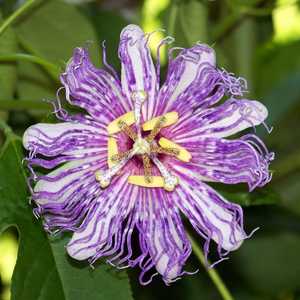
Passiflora “Passion Flower”, “Passionflower”, or “Passion Vine”
Herbaceous or Woody Perennial Vine, Evergreen or Deciduous Shrub or Tree
Grow Zones: 6-11
Lighting: Full sun to partial shade
Toxic to pets: No
Popular Varieties: Blue, Citrina, Maypop, Lady Margaret
Passion flowers are a group of vines and shrubs that are known for their striking, intricate flowers that come in a range of colors including white, pink, red, purple, and blue.
The name “passion flower” comes from the Christian symbolism associated with the plant. The unique structure of the flower was said to represent the passion of Christ, with the ten petals and sepals representing the ten apostles present at the crucifixion, the five anthers representing the wounds of Christ, and the three stigmas representing the nails used in the crucifixion. Passion flowers are also associated with passion and love in many cultures, and are often used in floral arrangements and romantic gifts.
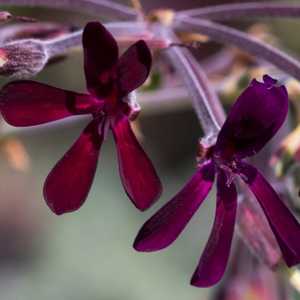
Pelargonium “Geranium”
Herbaceous Perennials, Evergreen Shrubs
Grow Zones: 9-12
Lighting: Full sun to partial sun
Toxic to pets: Yes
Popular Varieties: P. sidoides (shown), Attar of Roses, Cinnamon, Lady Plymouth, Nutmeg Hybrid, Lady Scarborough
Pelargonium is a genus of flowering plants in the Geraniaceae family that includes over 200 species. They are often confused with Geraniums, given that Geranium is also the botanical and common name of a separate genus of related plants (also called cranesbills), but Pelargoniums are typically more showy and have larger, more brightly colored blooms with two larger petals on top and three smaller petals on the bottom.
Pelargoniums are often grown for their attractive foliage as well as their flowers. Many species have leaves that are fragrant and decorative, with intricate patterns and textures.
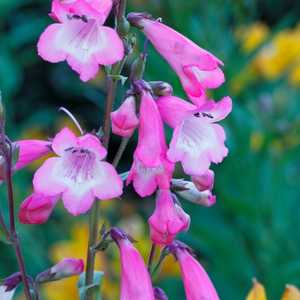
Penstemon “Beardtongue”
Deciduous or Evergreen Perennial or Shrub
Grow Zones: 3-9
Lighting: Full sun to partial sun
Toxic to pets: Unknown, assume yes
Popular Varieties: Scented Penstemon, Foxglove Beardtongue, Foothill Beardtongue, Arabesque Red Beardtongue
Commonly known as beardtongues due to their hairy stamens, penstemons are tubular flowers that come in a range of colors including purple, pink, red, blue, and white.
Penstemon flowers are pollinated by hummingbirds, bees, and other insects, and are also often visited by butterflies. Penstemon flowers have a long blooming period, typically from late spring to mid-summer. They are an easygoing plant and are tolerant of a wide range of conditions, including heat, drought, and poor soil.
Penstemon flowers are often used in wildflower meadows, rock gardens, and cottage gardens, and are a popular choice for attracting pollinators to the garden.
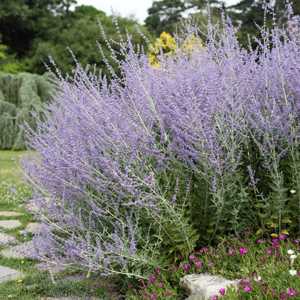
Perovskia “Russian Sage”
Herbaceous Woody Perennial or Deciduous Subshrub
Grow Zone: 4-9
Lighting: Full sun
Toxic to pets: No
Popular Varieties: Sage Advice, Lacey Blue, Blue Spire
Perovskia, also known as Russian sage, are known for their delicate, feathery foliage and spiky, lavender-blue flowers. They are highly attractive to bees, butterflies, and other pollinators.
Perovskia flowers have a long blooming period, typically from mid-summer to early fall. They are drought-tolerant and can grow in a wide range of soil types, making them a popular choice for xeriscaping and other low-water gardens. Perovskia flowers are also deer-resistant, which makes them a good choice for gardens in areas with high deer populations.
Perovskia flowers have a distinctive fragrance that is often described as spicy or herbal. The leaves of the plant are also highly fragrant, and can be used in potpourri or as a natural insect repellent.

Petunia
Herbaceous Annual or Perennial (dependent on zone grown)
Grow Zone: 2-11
Lighting: Full sun to partial sun
Toxic to pets: No
Popular Varieties: Easy Wave, Shock Wave, Supertunia, Tidal Wave, Wave
Petunias are commonly grown as ornamental plants in gardens and containers. The petunia flower comes in a wide range of colors, including pink, purple, white, red, and blue, and can have single or double blooms.
Petunias are easy to grow and require minimal maintenance. They prefer full sun and well-drained soil, but can tolerate some shade and drought. They are also fairly resistant to pests and diseases, which makes them a popular choice for beginner gardeners.
Petunia flowers are often used in garden design for their versatility and color. They are commonly used in hanging baskets, window boxes, and as borders or groundcover. Additionally, petunias are a favorite of hummingbirds and other pollinators, making them a great addition to any wildlife garden.
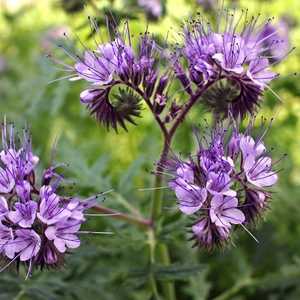
Phacelia “Scorpionweed”
Herbaceous, varies by variety
Grow Zone: 5-10
Lighting: Full sun to partial sun
Toxic to pets: No
Popular Varieties: Desert Bluebell, Silky Phacelia, Lacy Phacelia
Phacelia flowers are typically lavender-blue or purple, and have a delicate, lacy appearance. They are often grown as cover crops and ornamental plants, and highly attractive to bees and other pollinators; they’re also used in habitat restoration projects, as they can help to increase plant diversity and support a range of wildlife.
Phacelia flowers are easy to grow and require minimal maintenance. They prefer well-drained soil and full sun, but can tolerate some shade and drought. Phacelia flowers are often used in wildflower meadows, pollinator gardens, and as groundcover.
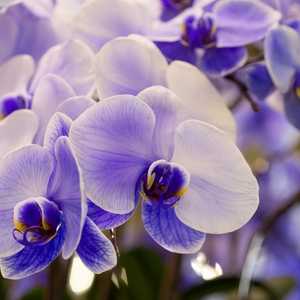
Phalaenopsis “Moth Orchid”
Evergreen, Epiphytic Orchid
Grow Zone: 10-12
Lighting: Partial sun
Toxic to pets: No
Popular Varieties: Moth Orchid cultivars, Cornu-Cervi, Stuartiana, Papagayo, Amabilis, Bellina, Schilleriana
Phalaenopsis, also known as moth orchids, are a popular group of orchids that are known for their large, showy blooms, which can last for several months. Phalaenopsis orchids come in a wide range of colors, including white, pink, purple, and yellow.
Phalaenopsis orchids are epiphytic, which means they grow on other plants and trees in their native habitat. They have adapted to growing in the crevices of bark and other organic material, and absorb nutrients and water through their aerial roots. Phalaenopsis orchids are commonly grown in pots or hanging baskets, and require a well-draining potting mix that mimics their natural growing conditions.
Phalaenopsis orchids are relatively easy to care for, and are a popular choice for beginners and experienced orchid enthusiasts alike. They prefer bright, indirect light and warm temperatures, and should be watered only when the potting mix is dry. Phalaenopsis orchids can also be propagated from stem cuttings, and many hybrid varieties have been developed over the years that have unique colors and patterns.
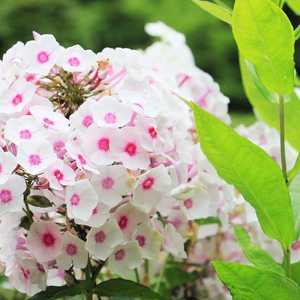
Phlox
Herbaceous Perennial
Grow Zone: 3-9 depending on variety
Lighting: Full sun to partial sun
Toxic to pets: No
Popular Varieties: Garden Phlox, Creeping Phlox, Hybrids
Phlox are known for their colorful, fragrant blooms, which come in shades of pink, purple, blue, and white. Phlox flowers typically have five petals and a distinctive, star-shaped appearance.
Phlox flowers are highly attractive to butterflies and hummingbirds, and are an important food source for many pollinators. They prefer well-drained soil and full sun to partial shade, and are commonly used in wildflower meadows, cottage gardens, and borders.
Phlox flowers have a long blooming period, typically from mid-summer to early fall. They are easy to grow and require minimal maintenance, making them a popular choice for gardeners of all levels.
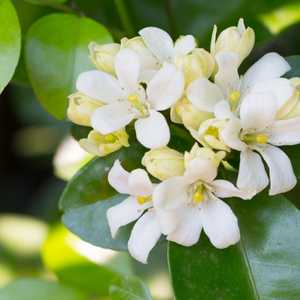
Pittosporum
Evergreen Shrubs or Small Trees
Grow Zone: 8-12 depending on variety
Lighting: Full sun to partial sun
Toxic to pets: No
Popular Varieties: Stiffleaf Cheesewood/Karo, Wheeler’s Dwarf, Mock Orange, Marjorie Channon
Pittosporum are known for their glossy, leathery leaves and fragrant flowers. Pittosporum flowers are typically small and inconspicuous, and come in shades of white, yellow, and purple.
Pittosporum flowers are highly attractive to bees and other pollinators. They typically bloom in the spring or early summer and produce large amounts of nectar, which provides an important food source for bees and helps to support local ecosystems. Pittosporum shrubs and trees are commonly grown in gardens and as ornamental plants, and require well-draining soil and full to partial sun.
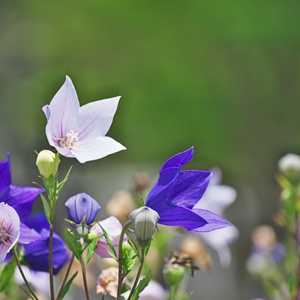
Platycodon “Balloon Flower”
Herbaceous Perennial
Grow Zone: 3-8
Lighting: Full sun to partial sun
Toxic to pets: No
Popular Varieties: Astra varieties, Fuji Blue, Hakone varieties, Mother of Pearl
Platycodon are commonly known as balloon flowers due to the unique shape of their buds. Platycodon flowers come in shades of blue, purple, pink, and white, and have a distinctive star-shaped appearance.
Platycodon are highly attractive to bees and other pollinators. They prefer well-drained soil and full sun to partial shade, and are commonly used in cottage gardens, borders, and rock gardens. Platycodon flowers have a long blooming period, typically from mid-summer to early fall. They are tolerant of drought and can grow in a wide range of soil types, which makes them a popular choice for low-maintenance gardens.
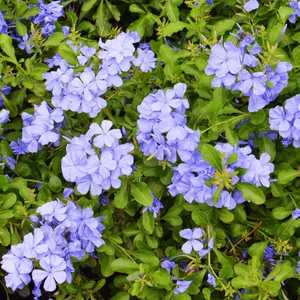
Plumbago “Cape Leadwort” or “Cape Plumbago”
Annual, Perennial, or Evergreen Shrub
Grow Zone: 8-11
Lighting: Full sun to partial sun
Toxic to pets: Yes
Popular Varieties: P. auriculata (shown), P. indica, P. europaea
Plumbago (Plumbago spp., NOT Ceratostigma plumbaginoides – both are called plumbago) are known for their beautiful, sky-blue flowers. Plumbago flowers are small and star-shaped, and grow in clusters on long, slender stems.
Plumbago flowers are highly attractive to bees, butterflies, and other pollinators. They prefer full sun and well-drained soil, and are commonly used in gardens, borders, and as groundcover. Plumbago plants are also fairly drought-tolerant and can grow in a wide range of soil types.
Plumbago flowers have a long blooming period, typically from late spring to early fall. They are fairly easy to care for and require minimal maintenance, making them a popular choice for gardeners of all levels.
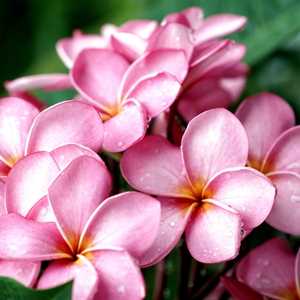
Plumeria “Frangipani”, “Hawaiian Lei Flower”
Deciduous or Evergreen Shrubs or Small Trees
Grow Zone: 10-12
Lighting: Full Sun
Toxic to pets: Yes
Popular Varieties: Plumeria rubra, Plumeria obtusa, Plumeria alba
Plumeria are highly fragrant and come in a range of colors, including white, pink, red, yellow, and orange. They have a long blooming period, typically from spring to fall.
Plumeria flowers are highly attractive to butterflies and other pollinators. They are commonly grown as ornamental plants in gardens and containers, and are also used in traditional Hawaiian leis, as well as traditional hula dances and ceremonies. Plumeria plants require full sun and well-drained soil, and can be grown from stem cuttings or grafts.
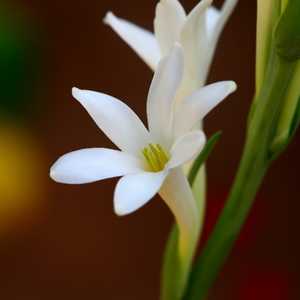
Polianthes tuberosa “Tuberose”
Herbaceous Perennial
Grow Zone: 7-11
Lighting: Full sun
Toxic to pets: Yes
Popular Varieties: Mexican, The Pearl
Polianthes tuberosa, also known as the tuberose, are known for their highly fragrant, white, waxy flowers, which bloom in clusters on tall spikes. Their scent is often described as sweet, exotic, and heady, and is commonly used in perfumes and other fragrances.
Polianthes tuberosa flowers are often grown for their ornamental value and are a popular choice for gardens, containers, and as cut flowers. They prefer well-drained soil and full sun, and require regular watering to thrive. Polianthes tuberosa plants can also be grown from bulbs, which are commonly available from nurseries and garden centers.
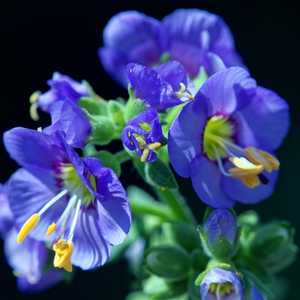
Polemonium “Jacob’s Ladder”
Herbaceous Annual or Perennial
Grow Zone: 2-9 depending on variety
Lighting: Full sun to partial sun
Toxic to pets: No
Popular Varieties: P. boreale, P. caeruleum, P. reptans, P. yezoense var. hidakanum
Polemonium are known for their beautiful, bell-shaped flowers, which come in shades of blue, pink, white, and purple. Polemonium flowers typically have five petals and grow in clusters on tall, slender stems.
Polemonium flowers are highly attractive to bees, butterflies, and other pollinators. They prefer well-drained soil and partial to full sun, and are commonly used in gardens, borders, and as groundcover. Polemonium plants are also fairly drought-tolerant and can grow in a wide range of soil types.
Polemonium flowers have a long blooming period, typically from late spring to early summer. They are easy to care for and require minimal maintenance, making them a popular choice for gardeners of all levels.
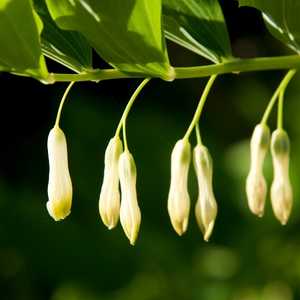
Polygonatum “Solomon’s Seal”
Herbaceous Perennial
Grow Zone: 3-8
Lighting: Partial sun to shade
Toxic to pets: Yes
Popular Varieties: Common Solomon’s Seal, Variegated Fragrant Solomon’s Seal, Great Solomon’s Seal
Polygonatum are known for their delicate, bell-shaped flowers, which are typically white or greenish-yellow. Polygonatum flowers are small and grow in pairs or clusters along arching stems.
Polygonatum flowers are highly attractive to bees and other pollinators. They prefer partial to full shade and moist, well-drained soil, and are commonly used in woodland gardens, shade borders, and as groundcover. Polygonatum plants are also fairly easy to care for and require minimal maintenance.
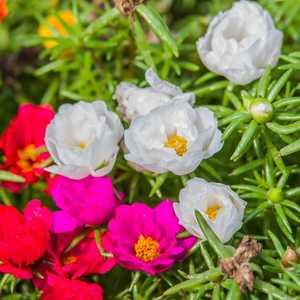
Portulaca grandiflora “Moss Rose”
Herbaceous Annual
Grow Zone: 2-12
Lighting: Full sun
Toxic to pets: Yes
Popular Varieties: Sundance, Calypso Mix, Duet, Fairytale, Happy Hour
Portulaca grandiflora, also known as moss rose, are typically small and come in shades of yellow, orange, and pink, and are highly attractive to bees and other pollinators.
Moss roses have a short blooming period, typically from mid-summer to early fall. They’re a popular choice for gardens, particularly in hot, dry regions, due to their heat and drought tolerance. They prefers well-drained soil and full sun, and are commonly used in rock gardens, hanging baskets, and as groundcover. They can also be grown from seed and are relatively easy to propagate.
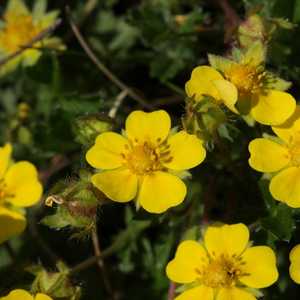
Potentilla “Cinquefoil”
Herbaceous Annual or Perennial, Deciduous Shrub
Grow Zone: 3-8 depending on variety
Lighting: Full sun to partial sun
Toxic to pets: No
Popular Varieties: Shrubby Cinquefoil, Scarlet Cinquefoil, P. atrosanguinea, P. alba
Potentilla are known for their attractive, five-petaled flowers, which come in shades of white, yellow, pink, and red. Potentilla flowers are typically small and grow in clusters on bushy or trailing plants.
Potentilla flowers are highly attractive to bees and other pollinators. They prefer full sun to partial shade and well-drained soil, and are commonly used in gardens, borders, and as groundcover. Potentilla plants are also fairly drought-tolerant and can grow in a wide range of soil types.
Potentilla flowers have a long blooming period, typically from late spring to early fall. They are easy to care for and require minimal maintenance, making them a popular choice for gardeners of all levels.
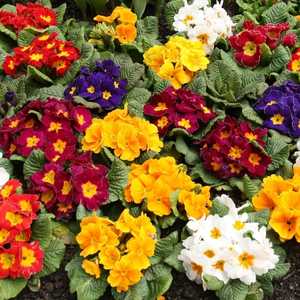
Primula “Primrose”
Herbaceous Perennial
Grow Zone: 4-8
Lighting: Full sun to partial sun
Toxic to pets: Yes
Popular Varieties: Belarina, Polyanthus Primrose, P. auricula, Japanese Primrose
Primula are known for their brightly colored, fragrant flowers, which come in shades of white, yellow, pink, purple, and red. The flowers are typically small and grow in clusters on rosettes of basal leaves.
Primula flowers are highly attractive to bees and other pollinators. They prefer moist, well-drained soil and partial to full shade, and are commonly used in gardens, borders, and as container plants. Primula plants are also fairly cold-tolerant and can withstand frost and snow.
Primula flowers have a long blooming period, typically from late winter to early summer. They are easy to care for and require minimal maintenance, making them a popular choice for gardeners of all levels.
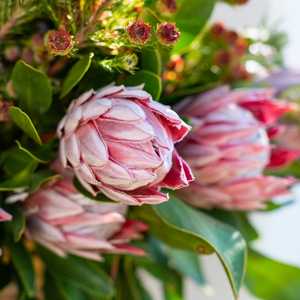
Protea “Sugarbushes”
Evergreen Shrubs
Grow Zone: 9-12
Lighting: Full sun
Toxic to pets: Yes
Popular Varieties: King Protea, Pink Minks
Protea are native to South Africa and are known for their unique, showy flowers, which come in a variety of shapes, sizes, and colors. Protea flowers are typically large and have a distinctive, cone-like shape, with dense clusters of long, narrow petals surrounding a central disk.
Protea flowers are highly prized by florists and horticulturists for their beauty and durability. They are commonly used in floral arrangements and are a favorite of gardeners due to their drought and heat tolerance. Protea plants are also highly attractive to birds and other pollinators, and are an important source of food and habitat for many species.
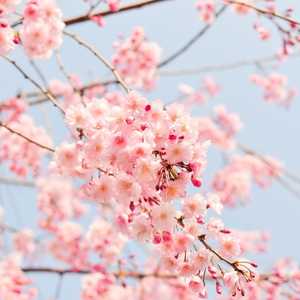
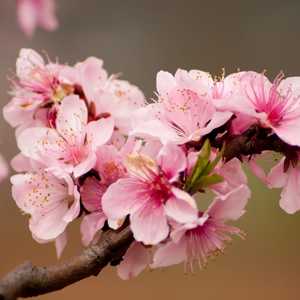
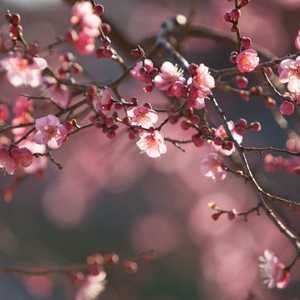
Prunus “Cherry Blossom”, “Peach Blossom”, and “Plum Blossom”
Deciduous Shrubs or Trees
Grow Zone: 4-9 depending on variety
Lighting: Full sun to partial sun
Toxic to pets: Yes
Popular Varieties: Japanese Flowering Cherry, Weeping Cherry, Chinese Peach Tree, Chinese Plum Tree
Prunus are known for their showy, fragrant flowers, which come in shades of pink, white, and red. Prunus flowers typically have five petals and grow in clusters on woody, deciduous trees or shrubs.
Prunus flowers are highly attractive to bees and other pollinators. They prefer full sun to partial shade and well-drained soil, and are commonly used in gardens, parks, and along streets and highways. Prunus trees and shrubs are also widely cultivated for their edible fruit, including cherries, plums, and peaches.
Prunus flowers have long been associated with cultural and symbolic meanings. In Japanese culture, cherry blossom season is celebrated with picnics and festivals, and the flowers are a symbol of the transient nature of life. In Chinese culture, peach blossoms are a symbol of longevity and prosperity. The plum blossom is also the national flower of the Republic of China and is one of the most beloved flowers in China.
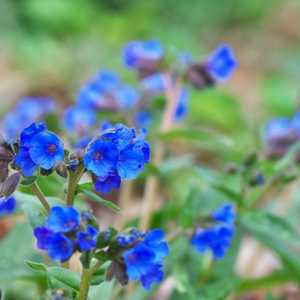
Pulmonaria “Lungwort”
Herbaceous or Semi-Evergreen Perennial
Grow Zone: 4-9
Lighting: Partial Sun to Shade
Toxic to pets: Yes
Popular Varieties: Blue Ensign, Raspberry Splash, Victorian Brooch
Pulmonaria are known for their attractive, spotted foliage and beautiful, funnel-shaped flowers, which come in shades of pink, blue, and purple. Pulmonaria flowers are typically small and grow in clusters on hairy stems.
Pulmonaria plants are highly attractive to bees and other pollinators. They prefer moist, well-drained soil and partial to full shade, and are commonly used in woodland gardens, shade borders, and as groundcover. Pulmonaria plants are also fairly low-maintenance and can tolerate a range of soil types on top of being deer-resistant.
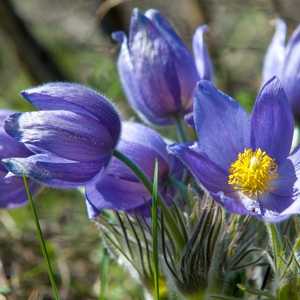
Pulsatilla “Pasque Flower” also “Pasqueflower”
Herbaceous Perennial
Grow Zone: 5-7
Lighting: Full sun
Toxic to pets: Yes
Popular Varieties: P. vulgaris, P. halleri, P. alpina
Pulsatilla are known for their showy, bell-shaped flowers, which come in shades of white, pink, red, purple, and blue. Pulsatilla flowers typically have six petals and grow on hairy, upright stems.
Pulsatilla plants are highly attractive to bees and other pollinators. They prefer well-drained soil and full sun to partial shade, and are commonly used in rock gardens, meadows, and as container plants. Pulsatilla are also fairly low-maintenance and can tolerate cold and drought.
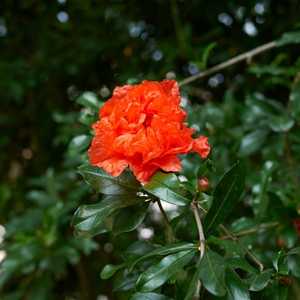
Punica granatum “Pomegranate”
Shrub, Evergreen in tropical areas
Grow Zone: 7-11
Lighting: Full sun
Toxic to pets: Yes
Popular Varieties: Pomegranate, Dwarf Pomegranate
Punica granatum, commonly known as pomegranate, is a fruit-bearing tree or shrub cultivated for its delicious, juicy, ruby-red arils, which are packed with antioxidants and nutrients. Pomegranate flowers are typically bright red or orange, and grow on the tips of branches in clusters.
Flowers That Start With P by Common Name
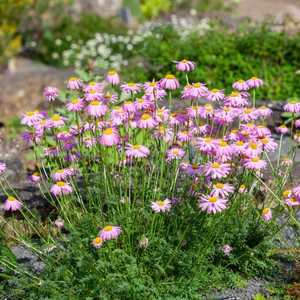
Painted Daisy (Tanacetum coccineum)
Herbaceous perennial
Grow Zone: 3-7
Lighting: Full sun to partial sun
Toxic to pets: Yes
Popular Varieties: Robinson’s Red, Brena, Mont Blanc, Eileen May Robinson, Mrs. James Kelway
The painted daisy, also known as Tanacetum coccineum, is known for its vibrant, colorful flowers, which come in shades of pink, white, and red. Painted daisies are typically large and grow in clusters on long, slender stems.
Painted daisy is commonly grown as an ornamental plant and is a popular choice for gardens and borders due to its showy flowers and attractive foliage. It prefers full sun to partial shade and well-drained soil, and is fairly low-maintenance and easy to care for.
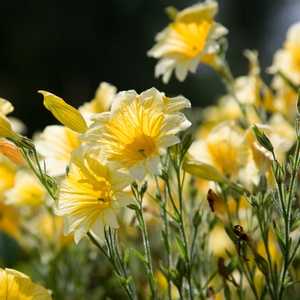
Painted Tongue (Salpiglossis sinuata)
Herbaceous Annual or Short-lived Perennial
Grow Zone: 10-11
Lighting: Full sun
Toxic to pets: Yes
Popular Varieties: Colors vary
Salpiglossis sinuata, commonly known as the painted tongue, is known for its attractive, trumpet-shaped flowers, which come in a wide range of colors, including shades of pink, purple, red, orange, and yellow. Painted tongue flowers have distinctive, veined markings on the petals.
The painted tongue flower is a popular choice for gardens, borders, and containers, due to its showy, long-lasting flowers and attractive foliage. It prefers full sun to partial shade and well-drained soil, and is fairly low-maintenance and easy to care for.
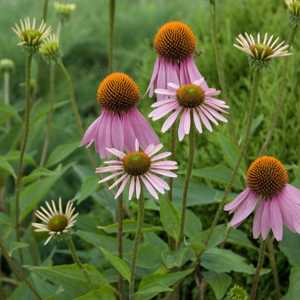
Pale Purple Coneflower (Echinacea pallida)
Grow Zone: 3-10
Lighting: Full sun
Toxic to pets: Yes, in large amounts
Popular Varieties: Hula Dancer
Echinacea pallida, also known as pale purple coneflower, is a species of flowering plant in the Asteraceae family, native to North America. It is known for its showy, daisy-like pale purple flowers (sometimes pink), and have a distinctive central cone-shaped disk. The flowers bloom in late spring or early summer and attract bees and other pollinators.
Echinacea pallida is a popular ornamental plant, commonly used in gardens, borders, and naturalistic landscapes. It prefers full sun and well-drained soil and is fairly drought-tolerant. Echinacea plants are also fairly low-maintenance and easy to care for, making them a favorite of gardeners of all levels.
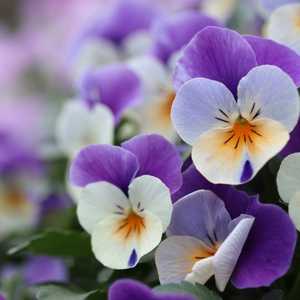
Pansy (Viola x wittrockiana)
Biennial or Short-lived Perennial, Grown as Annual
Grow Zone: 4-10 depending on variety
Lighting: Full sun to partial sun
Toxic to pets: No
Popular Varieties: Wonderfall series, Cool Wave series, Frizzle Sizzle series, Plentifall series, Delta series, Matrix series, Swiss Giants, Mammoth series
Pansies are known for their colorful, heart-shaped flowers, which come in a wide range of colors, including shades of yellow, purple, red, and blue. The pansy flower has a distinctive “face” with overlapping petals that resemble whiskers and a central blotch.
Pansies are a popular choice for gardens, borders, and containers, due to their long blooming period, showy flowers, and attractive foliage. They prefer cool weather and partial to full sun and are commonly planted in the fall or early spring.
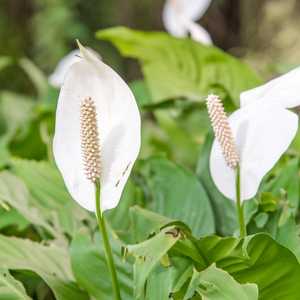
Peace Lily (Spathiphyllum)
Herbaceous Perennial
Grow Zone: 11-12
Lighting: Partial sun to partial shade
Toxic to pets: Yes
Popular Varieties: Power Petite, Mauna Loa Supreme, Sensation, Starlight, Golden Delicious
Peace lilies, also known as Spathiphyllum, are known for their attractive, glossy leaves and white flowers, which are shaped like a spade and bloom in spring and summer. Peace lilies are relatively easy to care for and prefer low to medium light conditions.
Peace lilies have air-purifying properties and can help remove harmful pollutants from the air, such as formaldehyde, benzene, and trichloroethylene. This makes them a great plant for indoor environments, as they can help improve air quality and create a healthier living space. However, it is important to note that the plant is toxic to pets and humans if ingested, so it should be kept out of reach of children and animals.
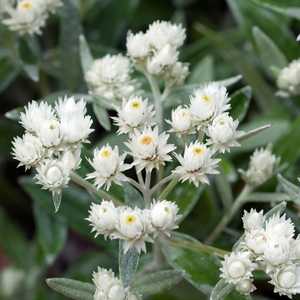
Pearly Everlasting (Anaphalis)
Woody Herbaceous Perennial
Grow Zone: 3-8
Lighting: Full sun to partial sun
Toxic to pets: No
Popular Varieties: A. margaritacea, A. triplinervis
Pearly Everlasting flowers, known as Anaphalis, are known for their attractive, papery flowers, which are typically white, yellow, or pink and have a woolly texture. Pearly Everlasting bloom in late summer and fall and grow on tall, slender stems.
Anaphalis plants are a popular choice for gardens, borders, and naturalistic landscapes. They prefer full sun to partial shade and well-drained soil, and are fairly drought-tolerant. Anaphalis plants are also fairly low-maintenance and easy to care for, making them a favorite of gardeners of all levels.
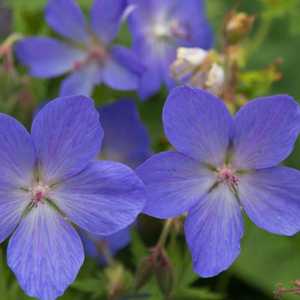
Periwinkle (Vinca)
Perennial or Subshrub
Grow Zone: 4-9 depending on variety
Lighting: Full sun, partial sun, shade
Toxic to pets: Yes
Popular Varieties: Vinca major, Vinca minor
Periwinkles, also known as vincas, are known for their attractive, evergreen foliage and showy, five-petaled flowers, which come in shades of blue, purple, pink, and white. Vinca flowers bloom in the spring and summer and grow on trailing stems.
Periwinkle is commonly used as a groundcover, due to its ability to quickly spread and form a dense, weed-suppressing carpet. It prefers partial to full sun and well-drained soil and is fairly drought-tolerant. It is also used in containers and hanging baskets, and is a popular choice for landscapes and naturalistic gardens.
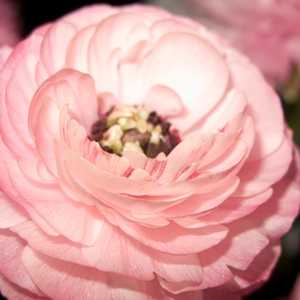
Persian Buttercup (Ranunculus asiaticus)
Herbaceous Perennial
Grow Zone: 8-11
Lighting: Full sun
Toxic to pets: Yes
Popular Varieties: Cloni series, Delano series, Elegance series, Tecolote series, Tomer series
The Persian buttercup, also known as Ranunculus asiaticus, is known for its showy, brightly colored flowers, which come in shades of pink, red, orange, yellow, and white. Ranunculus asiaticus flowers bloom in the spring and are popular in cut flower arrangements.
The Persian buttercup is commonly grown as a garden plant and is a popular choice for borders, containers, and naturalistic landscapes. It prefers full sun and well-drained soil and is fairly low-maintenance and easy to care for.
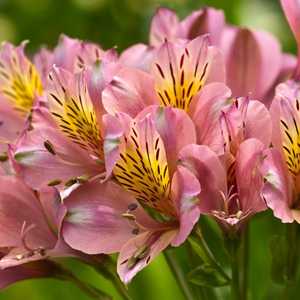
Peruvian Lily (Alstroemeria)
Herbaceous Perennial
Grow Zone: 7-10
Lighting: Full sun to partial sun
Toxic to pets: No
Popular Varieties: Princess series, A. inticancha
Peruvian lilies, also known as Alstroemeria, are known for their showy, funnel-shaped flowers, which come in a wide range of colors, including shades of pink, purple, orange, red, and white. Peruvian lilies have a distinctive pattern of stripes and dots on their petals and bloom in the spring and summer.
Peruvian lilies are a popular choice for cut flower arrangements due to their long vase life, attractive flowers, and wide range of colors. They are also commonly grown as a garden plant and are a favorite of gardeners due to their low-maintenance nature and long blooming period. Peruvian lilies prefer full sun to partial shade and well-drained soil, and are fairly drought-tolerant.
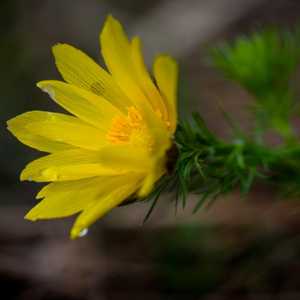
Pheasant’s Eye (Adonis)
Herbaceous Perennial
Grow Zone: 3-7
Lighting: Full sun to partial shade
Toxic to pets: Yes
Popular Varieties: A. amur, A. vernalis
Pheasant’s eye, also known as Adonis, is known for its striking, bright yellow flowers, which resemble a buttercup and bloom in early spring. Pheasant’s eye grows up to 30 cm tall and has attractive, fern-like foliage.
Pheasant’s eye is commonly grown as a garden plant and is a popular choice for rock gardens, borders, and naturalistic landscapes. It prefers full sun to partial shade and well-drained soil and is fairly low-maintenance and easy to care for.
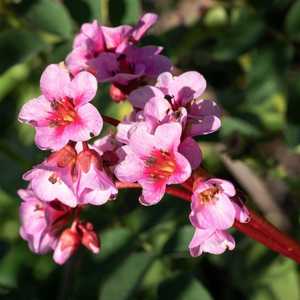
Pigsqueak (Bergenia)
Evergreen Perennial
Grow Zone: 3-9
Lighting: Full sun to partial sun
Toxic to pets: No
Popular Varieties: Elephant’s Ears, Fringed Bergenia, Heartleaf Bergenia, Winter-Blooming Bergenia
Pigsqueak, also known as Bergenia, are known for their attractive, evergreen foliage and showy, bell-shaped flowers, which come in shades of pink, red, or white. Pigsqueak flowers bloom in the spring and grow on short, stout stems.
Pigsqueak is commonly grown as a garden plant and is a popular choice for borders, containers, and naturalistic landscapes. It prefers partial to full shade and moist, well-drained soil and is fairly low-maintenance and easy to care for.
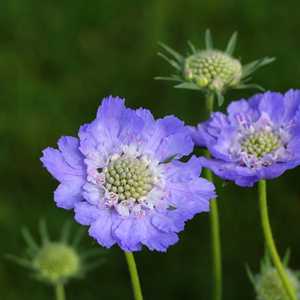
Pincushion Flower (Scabiosa)
Herbaceous Annuals or Perennials
Grow Zone: 3-10 depending on variety
Lighting: Full sun
Toxic to pets: No
Popular Varieties: Giga series, Butterfly Blue, S. atropurpurea, S. caucasica
Pincushion flowers, also known as Scabiosa, are known for their distinctive, pincushion-shaped flowers, which come in shades of blue, pink, white, and purple. Pincushion flowers bloom in the summer and fall and attract bees, butterflies, and other pollinators.
Pincushion flowers are commonly grown as garden plants and are a popular choice for borders, containers, and naturalistic landscapes. They prefer full sun to partial shade and well-drained soil and are fairly drought-tolerant.

Plantain Lily (Hosta)
Herbaceous Perennial
Grow Zone: 3-9
Lighting: Partial sun to shade
Toxic to pets: Yes
Popular Varieties: Curly Fries, Dancing Queen, Earth Angel, Fire and Ice, Fragrant Bouquet, First Frost
Plantain lilies, also known as Hosta, are known for their attractive, broad, and often variegated leaves, which come in shades of green, blue, yellow, and white. Hosta flowers are trumpet-shaped and come in shades of lavender, pink, and white.
Plantain lilies are commonly grown as garden plants and are a popular choice for borders, ground covers, and shade gardens. They prefer partial to full shade and moist, well-drained soil and are fairly low-maintenance and easy to care for.

Pompom Chrysanthemum
Herbaceous Annual or Perennial
Grow Zone: 5-9
Lighting: Full sun
Toxic to pets: Yes
Popular Varieties: Rocky, Lavender Pixie
Pompom chrysanthemums are a type of chrysanthemum characterized by their spherical flower heads made up of many small florets. They come in a variety of colors, including shades of white, yellow, pink, and purple. Pompom chrysanthemums bloom in the fall and are commonly used in cut flower arrangements, particularly in Asian cultures where they are highly valued.
Pompom chrysanthemums are commonly grown as garden plants and are a popular choice for borders, containers, and naturalistic landscapes. They prefer full sun to partial shade and well-drained soil and are fairly low-maintenance and easy to care for.

Pot Marigold (Calendula)
Herbaceous Annual
Grow Zone: 2-11 depending on variety
Lighting: Full sun to partial sun
Toxic to pets: Yes, in large amounts
Popular Varieties: C. officinalis, Lady Godiva series, Winter Wonders series
Pot marigolds, also known as calendula, are known for their bright, daisy-like flowers, which come in shades of orange, yellow, and cream. Pot marigold flowers bloom throughout the summer and fall.
Pot marigold is commonly grown as a garden plant and is a popular choice for borders, containers, and naturalistic landscapes. It prefers full sun to partial shade and well-drained soil and is fairly low-maintenance and easy to care for.
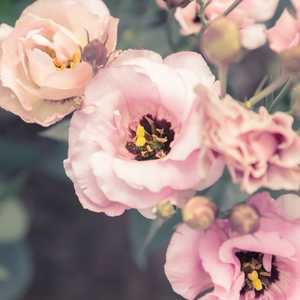
Prairie Gentian (Eustoma)
Herbaceous Annual or Perennial
Grow Zone: 7-10
Lighting: Full sun to partial shade
Toxic to pets: No
Popular Varieties: E. russellianum (originally E. grandiflora), E. exaltatum
Prairie gentians, also known as Eustoma and originally as Lisianthus, are known for their large, showy, bell-shaped flowers, which come in shades of blue, purple, pink, and white. Prairie gentian flowers bloom in the summer and fall and attract bees and other pollinators.
Prairie gentian is commonly grown as a garden plant and is a popular choice for borders, containers, and naturalistic landscapes. It prefers full sun and moist, well-drained soil and is fairly low-maintenance and easy to care for.
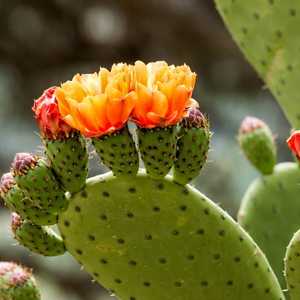
Prickly Pear (Opuntia)
Cactus
Grow Zone: 8-11
Lighting: Full sun
Toxic to pets: Yes
Popular Varieties: Santa Rita, Bunny Ears, Beavertail Cactus, Red-Flower Prickly Pear
Opuntia, also known as prickly pear cactus, are known for their distinctive flattened pads, which are covered in sharp spines and edible fruit. Prickly pear flowers are large and showy, and come in shades of yellow, orange, pink, and red. They bloom in the spring and summer, and are typically followed by the fruit.
Prickly pear cacti are commonly grown as an ornamental plant and are a popular choice for desert and xeriscape gardens. They prefer full sun and well-drained soil and are highly drought-tolerant.
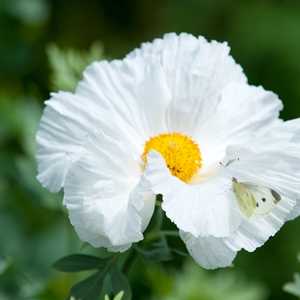
Pua Kala (Argemone glauca)
Perennial
Grow Zone: 9-10
Lighting: Full sun
Toxic to pets: Yes
Popular Varieties: Hawaiian Prickly Poppy
Pua Kala, also known as the Argemone glauca, is known for its distinctive, prickly stems and leaves and its large, showy, yellow flowers. The flowers bloom from spring to summer, and are followed by capsule fruits filled with many small seeds.
In Hawaii, Pua Kala has been used in traditional medicine to treat a range of ailments, including skin infections, headaches, and inflammation. The plant is also used in traditional Hawaiian ceremonies and is highly valued for its cultural and spiritual significance.
Pua Kala is commonly grown as an ornamental plant, and is a popular choice for wildflower gardens, rock gardens, and xeriscape landscapes. It is highly drought-tolerant, and thrives in hot, dry environments.

